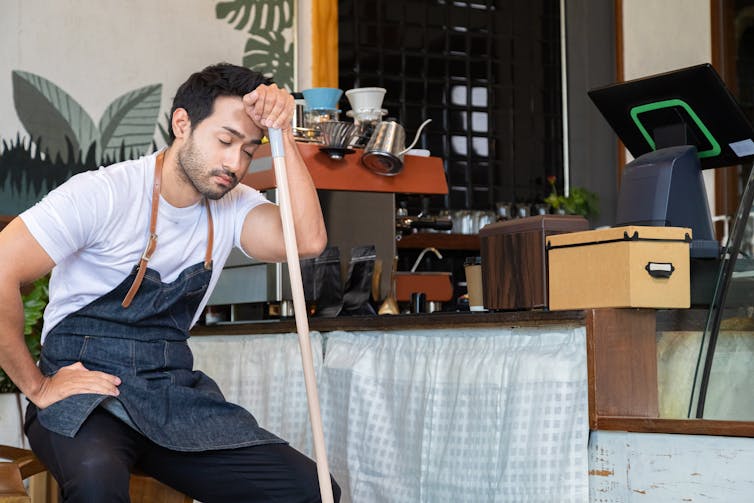We are living through a mass-disabling event: Over 200 million people worldwide have long COVID. In Canada, one in nine people have experienced long COVID symptoms, and this is likely an underestimate.
Occurring weeks to months after a COVID-19 infection, this multi-system chronic illness has led to what some have called “the shadow pandemic.” Although millions are navigating this new illness, four years into the pandemic both patients and their caregivers continue to face challenges accessing the information and care they need.
Most Canadians have had COVID, and at least one in five have been infected more than once. These trends are troubling because evidence suggests that the risk of acquiring long COVID increases with reinfection.
Long COVID
Long COVID is a complex illness that can present with a range of neurological and cardiovascular symptoms, such as post-exertional malaise, heart palpitations, cognitive impairment, fatigue and around 200 other symptoms. Some people with long COVID, often referred to as “longhaulers,” experience other under-researched syndromes, such as myalgic encephalomyelitis (ME) — also known as chronic fatigue syndrome.

With a suite of life-altering impacts, it is unsurprising that longhaulers may also experience impacts to their mental health, financial stability and relationships with others. These experiences are further exacerbated by the fact that there remains no cure for long COVID.
Over the past year, our team at Simon Fraser University has been speaking with long COVID patients, unpaid caregivers — such as family and friends who take on caregiving roles — clinicians and long COVID researchers to better understand patient experiences. In a new report, we documented a number of challenges patients and their caregivers face as well as recommendations to reduce these barriers.
Holistic approaches to care
Because symptoms and experiences vary, there is no single approach to care that will support all longhaulers. In British Columbia, post-COVID recovery clinics have been instrumental in creating specialized regional spaces for long COVID care.
These clinics have blended physician care, allied health care — such as physiotherapy and occupational therapy — and patient support groups. The closure of in-person clinics in transition to an online care system, in combination with long wait times, has meant that some patients have difficulty accessing these clinics.

Longhaulers have emphasized the value of specialized clinics and the need for holistic approaches that encompass allied health care to address the multifaceted impacts of long COVID on patients’ lives. Caregivers in particular expressed a need for mental health supports due to additional strains on their ability to work, their relationships and other responsibilities.
Holistic approaches are being embraced by some groups such as the Clinical Post COVID Society in the United Kingdom which brings together a “diverse multidisciplinary clinical leadership team to reflect the varied expertise needed to care for patients with long COVID.” This example may serve as a helpful model for mobilizing these approaches in Canada.
Information
Access to information about long COVID remains a significant challenge. While longhaulers obtain information from health-care providers (which can vary and be contradictory), many are unable to meet with a doctor.
In B.C., approximately one in five people don’t have a family doctor. As a result, many are left to search for information themselves, wading through websites and articles while trying to discern what to trust. This can be especially challenging for people experiencing brain fog and fatigue, or those limited in time and resources due to caregiving, work or other demands on their time.
Patients, caregivers, clinicians and researchers suggest that the federal government create a national long COVID information platform providing details about symptoms, symptom management, a database of health-care practitioners providing long COVID care, and updates on recent research.
This could be modelled off the Post-COVID MyGuide, produced by the Post-COVID Interdisciplinary Clinical Care Network in B.C.. And while such resources are critical to supporting longhaulers, they are only useful if people access them. Therefore, more investment is needed to raise awareness of these platforms, evaluate their usefulness and explore ways to scale them for national use.
Prevention
Another key outcome for improving care is refocusing preventive efforts to reduce reinfection risk for longhaulers, and future long COVID cases. Prevention measures might include campaigns promoting wearing respirators, regular vaccinations, increasing paid sick days or improving air filtration and ventilation indoors.
Preventing long COVID also involves taking these precautions in the absence of visible illness, as some early estimates suggested that 59 per cent of transmission occurs without symptoms.
Our team put these prevention measures into practice in April when we hosted a hybrid long COVID event with Pulitzer-prize winning journalist Ed Yong and a panel of patients, caregivers, clinicians and researchers. The event included safety measures such as mandatory masking in KN95/N95 respirators, rapid testing of participants and MERV-13 air filters.
Both during and since this event we have received numerous messages from longhaulers speaking to how the event and the safety measures in place were meaningful to them and made them feel seen. In order to do this, collectively (researchers, clinicians, policymakers and the public) can take many steps to create safe spaces as a baseline to reduce transmission risks.
As we continue to grapple with the enduring legacies of the COVID-19 pandemic, we must recognize that many communities have been disproportionately affected by SARS-CoV-2. To address these differential impacts, patients and caregivers advocate for continued investments in patient-centred research and care to create initiatives that resonate and are relevant for those most affected.
To further amplify these stories and raise awareness, our team is developing a long COVID “Day in the Life” photo exhibit in partnership with the Museum of Vancouver, where long COVID patients can share their stories and photos. Activities like this are one more step to making visible the experiences of people with an invisible illness.

